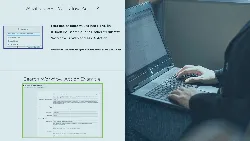
Advanced Threat Hunting With Splunk 
This course provides an in-depth look at advanced threat hunting with Splunk. It covers topics such as how to install Splunk on a Linux box, setting up universal forwarding, threat hunting, kill chain analysis, data analysis, and data sources and possibilities for 2021. Participants will gain a comprehensive understanding of the tools and techniques needed to effectively hunt for threats. ▼
ADVERTISEMENT
Course Feature
![]() Cost:
Cost:
Free
![]() Provider:
Provider:
Youtube
![]() Certificate:
Certificate:
Paid Certification
![]() Language:
Language:
English
![]() Start Date:
Start Date:
On-Demand
Course Overview
❗The content presented here is sourced directly from Youtube platform. For comprehensive course details, including enrollment information, simply click on the 'Go to class' link on our website.
Updated in [February 21st, 2023]
Splunk Tutorial (1): How to Install Splunk on a Linux Box.
Splunk Tutorial (2): How to Set Universal Forwarding.
Splunk Tutorial(3): Threat Hunting, Kill Chain, and Data analysis.
Splunk Tutorial(4): Data Sources & Possibilities 2021.
Splunk Tutorial(5): Basics, Search Queries and Boolean Logic.
Splunk Tutorial(6): Adding Data and Basic Queries 2021.
Splunk Tutorial(7): Queries and Searching Events 2021.
Splunk Tutorial(9): Explaining a Complex Query in 2021.
Search Commands & Critical Events In Splunk 2021.
(Please note that we obtained the following content based on information that users may want to know, such as skills, applicable scenarios, future development, etc., combined with AI tools, and have been manually reviewed)
This course, Advanced Threat Hunting With Splunk, provides an in-depth look into the world of threat hunting and data analysis. It covers topics such as how to install Splunk on a Linux box, setting up universal forwarding, threat hunting, kill chain, data analysis, data sources and possibilities, basics, search queries and boolean logic, adding data and basic queries, queries and searching events, explaining a complex query, and search commands and critical events in Splunk.
Possible Development Paths include becoming a Splunk Certified Architect, a Splunk Certified Developer, a Splunk Certified Admin, or a Splunk Certified Consultant. These certifications will demonstrate a mastery of the Splunk platform and its capabilities. Additionally, learners may pursue a career in cyber security, data analysis, or threat hunting.
Learning Suggestions for learners include taking courses in cyber security, data analysis, and threat hunting. Additionally, learners should practice their skills with Splunk by setting up their own environment and running queries. They should also read up on the latest trends in cyber security and threat hunting, and stay up to date with the latest developments in the field. Finally, they should join online communities and forums to discuss their experiences and learn from others.
[Applications]
Those who have completed the Advanced Threat Hunting With Splunk course can apply their knowledge to their own security operations. They can use Splunk to detect and investigate threats, analyze data, and create custom searches. They can also use Splunk to monitor and alert on critical events. Additionally, they can use Splunk to create custom dashboards and reports to better understand their security posture.
[Career Paths]
1. Cyber Security Analyst: Cyber Security Analysts are responsible for monitoring and analyzing security threats, developing security policies, and implementing security measures to protect an organization's data and systems. They must stay up to date on the latest security trends and technologies, and be able to identify and respond to potential threats. With the increasing complexity of cyber threats, the demand for Cyber Security Analysts is expected to grow significantly in the coming years.
2. Splunk Administrator: Splunk Administrators are responsible for managing and maintaining Splunk environments. They must be knowledgeable in Splunk architecture, installation, configuration, and troubleshooting. They must also be able to develop and maintain Splunk dashboards, reports, and alerts. As organizations increasingly rely on Splunk for their security and analytics needs, the demand for Splunk Administrators is expected to grow.
3. Threat Hunter: Threat Hunters are responsible for proactively identifying and responding to potential security threats. They must be knowledgeable in threat hunting techniques, such as data analysis, kill chain analysis, and reverse engineering. They must also be able to develop and maintain threat hunting strategies and processes. With the increasing complexity of cyber threats, the demand for Threat Hunters is expected to grow significantly in the coming years.
4. Security Engineer: Security Engineers are responsible for designing, developing, and maintaining secure systems and networks. They must be knowledgeable in security protocols, encryption, authentication, and access control. They must also be able to develop and maintain security policies and procedures. As organizations increasingly rely on secure systems and networks, the demand for Security Engineers is expected to grow.
Course Provider

Provider Youtube's Stats at AZClass
Discussion and Reviews
0.0 (Based on 0 reviews)
Explore Similar Online Courses

Face detection with OpenCV in Python OpenCV Python Tutorial for Beginners in 2021 Great Learning

Instagram 2020 Masterclass - A Blueprint to Grow Your Instagram Account

Python for Informatics: Exploring Information

Social Network Analysis

Introduction to Systematic Review and Meta-Analysis

The Analytics Edge

DCO042 - Python For Informatics

Causal Diagrams: Draw Your Assumptions Before Your Conclusions

Whole genome sequencing of bacterial genomes - tools and applications

Introduction to Splunk

Splunk: The Big Picture


Start your review of Advanced Threat Hunting With Splunk